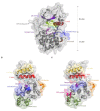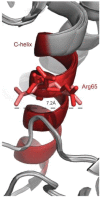Mutations That Confer Drug-Resistance, Oncogenicity and Intrinsic Activity on the ERK MAP Kinases-Current State of the Art
- PMID: 31935908
- PMCID: PMC7016714
- DOI: 10.3390/cells9010129
Mutations That Confer Drug-Resistance, Oncogenicity and Intrinsic Activity on the ERK MAP Kinases-Current State of the Art
Abstract
Unique characteristics distinguish extracellular signal-regulated kinases (Erks) from other eukaryotic protein kinases (ePKs). Unlike most ePKs, Erks do not autoactivate and they manifest no basal activity; they become catalysts only when dually phosphorylated on neighboring Thr and Tyr residues and they possess unique structural motifs. Erks function as the sole targets of the receptor tyrosine kinases (RTKs)-Ras-Raf-MEK signaling cascade, which controls numerous physiological processes and is mutated in most cancers. Erks are therefore the executers of the pathway's biology and pathology. As oncogenic mutations have not been identified in Erks themselves, combined with the tight regulation of their activity, Erks have been considered immune against mutations that would render them intrinsically active. Nevertheless, several such mutations have been generated on the basis of structure-function analysis, understanding of ePK evolution and, mostly, via genetic screens in lower eukaryotes. One of the mutations conferred oncogenic properties on Erk1. The number of interesting mutations in Erks has dramatically increased following the development of Erk-specific pharmacological inhibitors and identification of mutations that cause resistance to these compounds. Several mutations have been recently identified in cancer patients. Here we summarize the mutations identified in Erks so far, describe their properties and discuss their possible mechanism of action.
Keywords: CD domain; ERK1; ERK2; MAPK kinase; Rolled; SCH772984; VRT-11E; sevenmaker.
Conflict of interest statement
The authors declare no conflict of interest.
Figures


Similar articles
-
Intrinsically active variants of Erk oncogenically transform cells and disclose unexpected autophosphorylation capability that is independent of TEY phosphorylation.Mol Biol Cell. 2016 Mar 15;27(6):1026-39. doi: 10.1091/mbc.E15-07-0521. Epub 2015 Dec 10. Mol Biol Cell. 2016. PMID: 26658610 Free PMC article.
-
Discovery of a novel ERK inhibitor with activity in models of acquired resistance to BRAF and MEK inhibitors.Cancer Discov. 2013 Jul;3(7):742-50. doi: 10.1158/2159-8290.CD-13-0070. Epub 2013 Apr 24. Cancer Discov. 2013. PMID: 23614898
-
An Activating Mutation in ERK Causes Hyperplastic Tumors in a scribble Mutant Tissue in Drosophila.Genetics. 2020 Jan;214(1):109-120. doi: 10.1534/genetics.119.302794. Epub 2019 Nov 18. Genetics. 2020. PMID: 31740452 Free PMC article.
-
Targeting ERK1/2 protein-serine/threonine kinases in human cancers.Pharmacol Res. 2019 Apr;142:151-168. doi: 10.1016/j.phrs.2019.01.039. Epub 2019 Feb 20. Pharmacol Res. 2019. PMID: 30794926 Review.
-
Targeting oncogenic Raf protein-serine/threonine kinases in human cancers.Pharmacol Res. 2018 Sep;135:239-258. doi: 10.1016/j.phrs.2018.08.013. Epub 2018 Aug 15. Pharmacol Res. 2018. PMID: 30118796 Review.
Cited by
-
Navigating the ERK1/2 MAPK Cascade.Biomolecules. 2023 Oct 20;13(10):1555. doi: 10.3390/biom13101555. Biomolecules. 2023. PMID: 37892237 Free PMC article. Review.
-
All intrinsically active Erk1/2 mutants autophosphorylate threonine207/188, a plausible regulator of the TEY motif phosphorylation.J Biol Chem. 2025 Jun;301(6):108509. doi: 10.1016/j.jbc.2025.108509. Epub 2025 Apr 11. J Biol Chem. 2025. PMID: 40222547 Free PMC article.
-
RAF Kinases in Cancer: A Moving Target and Degradation Therapy.ACS Med Chem Lett. 2020 Jun 22;11(7):1369-1370. doi: 10.1021/acsmedchemlett.0c00299. eCollection 2020 Jul 9. ACS Med Chem Lett. 2020. PMID: 32676141 Free PMC article. No abstract available.
-
ERK pathway agonism for cancer therapy: evidence, insights, and a target discovery framework.NPJ Precis Oncol. 2024 Mar 14;8(1):70. doi: 10.1038/s41698-024-00554-5. NPJ Precis Oncol. 2024. PMID: 38485987 Free PMC article. Review.
-
From Deworming to Cancer Therapy: Benzimidazoles in Hematological Malignancies.Cancers (Basel). 2024 Oct 12;16(20):3454. doi: 10.3390/cancers16203454. Cancers (Basel). 2024. PMID: 39456548 Free PMC article. Review.
References
-
- Keith W.M., Kenichi N., Sara W. Recent advances of MEK inhibitors and their clinical progress. Curr. Top. Med. Chem. 2007;7:1364–1378. - PubMed
Publication types
MeSH terms
Substances
LinkOut - more resources
Full Text Sources
Research Materials
Miscellaneous

